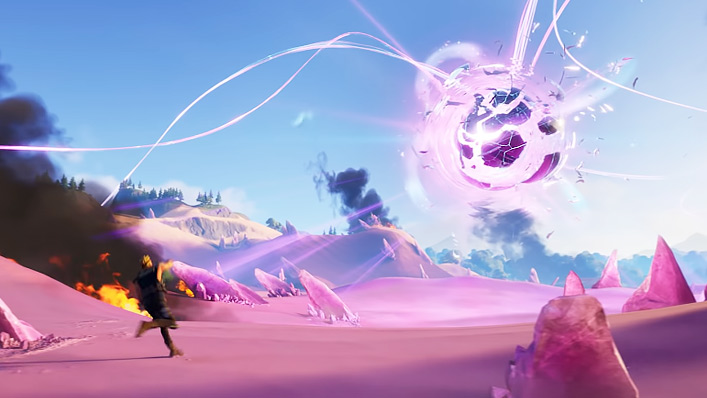Avengers directors the Russo brothers made the latest Fortnite intro – should we care?

The latest production from Anthony and Joe Russo—directors of Avengers: Endgame—is a cinematic video for the blockbuster game Fortnite. Critic Luke Buckmaster asks: what does this say about the current state of cinema and gaming?
Have you seen the intro sequence yet for the new season of Fortnite? If your response went something along the lines of “why would I have?” or “what on earth are you talking about?” it might be worth remembering that you’re on the outside of a cultural phenomenon—you chump—which is almost as big and blockbuster-y as they come. The juggernaut that is Fortnite is sort of a sport and sort of a platform, in addition to being of course a battle royale video game, with somewhere in the vicinity of 350 million players.
See also:
* All new streaming movies & series
* All movies now playing in cinemas
Like all video games it is real-time computer art, which offers the kind of narrative experiences cinema cannot—allowing a potentially infinite number of variations. The directors of this three minute video (which kicks off Fortnite chapter two, season six) are however purveyors of boilerplate movie experiences: Anthony and Joe Russo, who helmed some of the most widely watched motion pictures of the modern era—including the two-part MCU ‘finale’ Avengers: Infinity War and Avengers: Endgame.
The Fortnite video, dubbed the “Zero Crisis Story Cinematic”, collected millions of views on YouTube in just a few days, and is currently sitting on 6.1 million views on this platform alone. All of which, from the perspective of somebody who critiques films, TV and other works of pop culture, begs the question: if it’s normal for me to review a black-and-white documentary about the lives of a sow and her piglets (lookin’ at you, Gunda), which may be terrific but will attract only a small number of viewers, why isn’t it normal to write about Fortnite? An air of snobbishness has long surrounded conversations about video games. With that in mind, let’s dive in.
The Fortnite “Cinematic” follows Agent Jones (voice of Troy Baker, who voiced Joel from The Last of US) as he descends from an airborne Battle Bus onto a carnage-strewn island, in pursuit of a glowing purple orb. In other words the kind of dumb simple, goal-based plotline right at home with the Russos.
After landing, Jones is attacked by a Xenomorph XX121 (the alien from Alien), then saved by Linda Hamilton, then shot at by battle droids from Terminator. He runs past Ryu from Street Fighter—who hadouken-blasts Peely, an anthropomorphic banana, causing its pulpy yellow innards to splatter everywhere. After other fleeting encounters Jones makes a deal with a cyborg-esque character known as The Mountain, who agrees to assist him in his orb-seeking quest.

For a superior sequence that plays along similar lines—throwing loads of references, particularly from science fiction, into a pop culture mish-mash, driven by an original character navigating an unoriginal landscape—consult the opening scene of the HBO series Lovecraft Country. It injects literature into television the way the Russo’s port movies into a video game, while also saying something about the evolving state of motion pictures.
Like the characters in Wandavision, Lovecraft Country’s Atticus (Jonathan Majors) is trapped inside a retrograde reality, fighting in Korean War trenches in shots styled to resemble scratchy black and white newsreels. When he jumps up over the trenches and onto the battlefield, colour comes with him.
There are no such transformations in the “Zero Crisis Story Cinematic”, which was directed in the Russo brothers’ usual impersonal style, pitting unremarkable action in front of screensaver-like backgrounds. It’s littered with shots that look colourful but flavourless, like this one.

The video does however remind us that while the future of the cinema is uncertain, cinematic ways of seeing the world are here to stay. The influence of movies throughout the 20th century permeated cinematic images across virtually all aspects of culture, from billboards to shampoo commercials to smartphone backgrounds. And of course to video games. The term “cinematic” is difficult to define but there is evidence of it everywhere.
Video games such as Fortnite, which unfold from a third-person perspective, present a form of cinematic expression that positions the virtual camera behind the back of a character. There are loads of examples of this kind of framing being used in traditional films, including (to pluck one recent example) the sci-fi B movie Cosmic Sin, in early shots showing Bruce Willis walking towards a neon-coloured bar. It is also common throughout the work of Darren Aronofsky.
We get none of this in the Fortnite video. Nothing that doesn’t scream “cookie cutter”. The style of video game cutscenes (the word “cutscene” suggesting both the game is cutting to them, and that the scenes themselves have cuts) is to ignore the essence of what makes gaming visually interesting—and this one is no exception. Shots in the “Story Cinematic” tend to last for a few seconds while the game itself rarely cuts at all. The gameplay—like in most popular video games—provides lengthy unbroken sequences that are the filmmaking equivalent of long single takes.
For movie watchers who love long takes but aren’t gamers: you’re in the wrong medium. Video games are where it’s at. There is of course value in both kinds of experiences: those that sculpt images into beautiful cinematic visions, painterly but unalterable, and those that offer an infinite number of variations.














